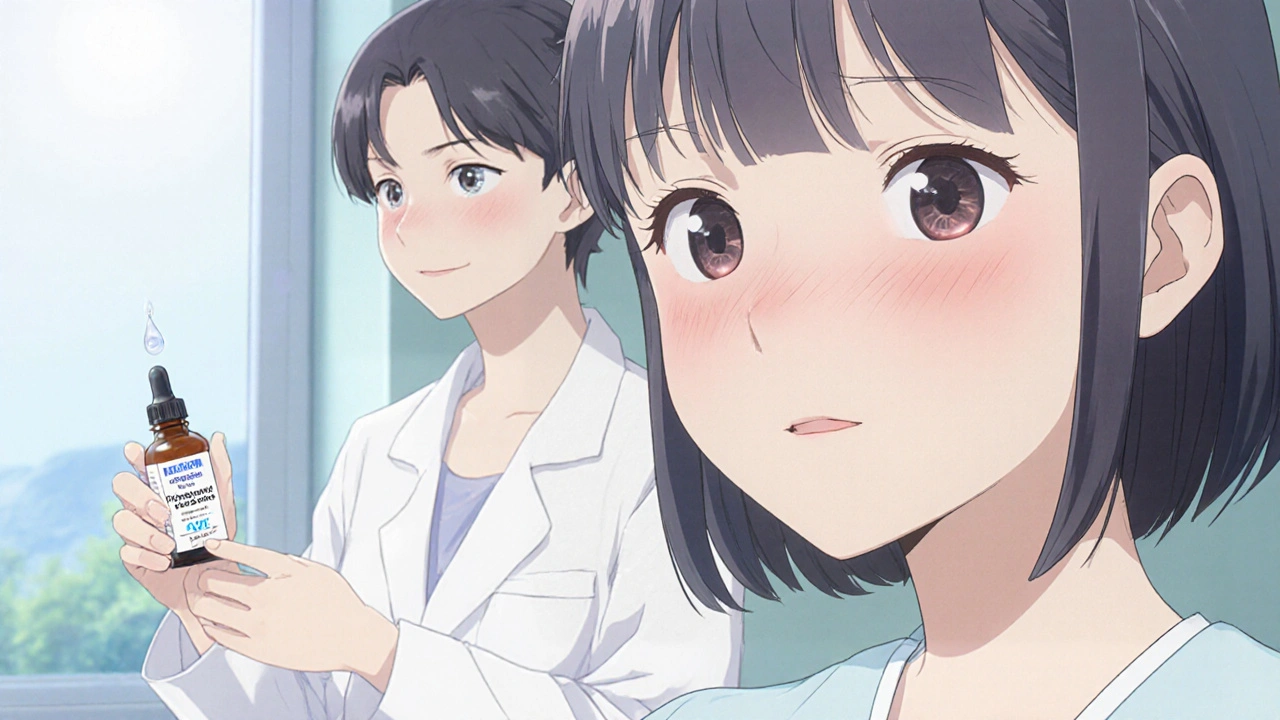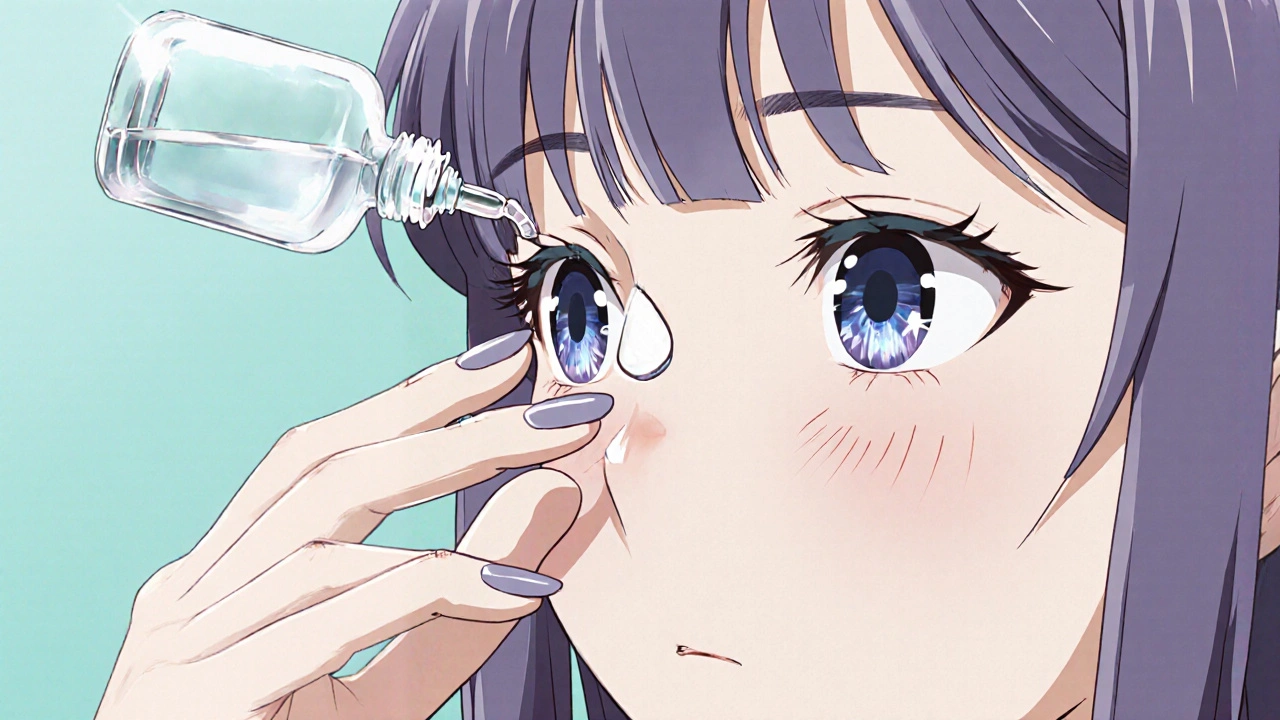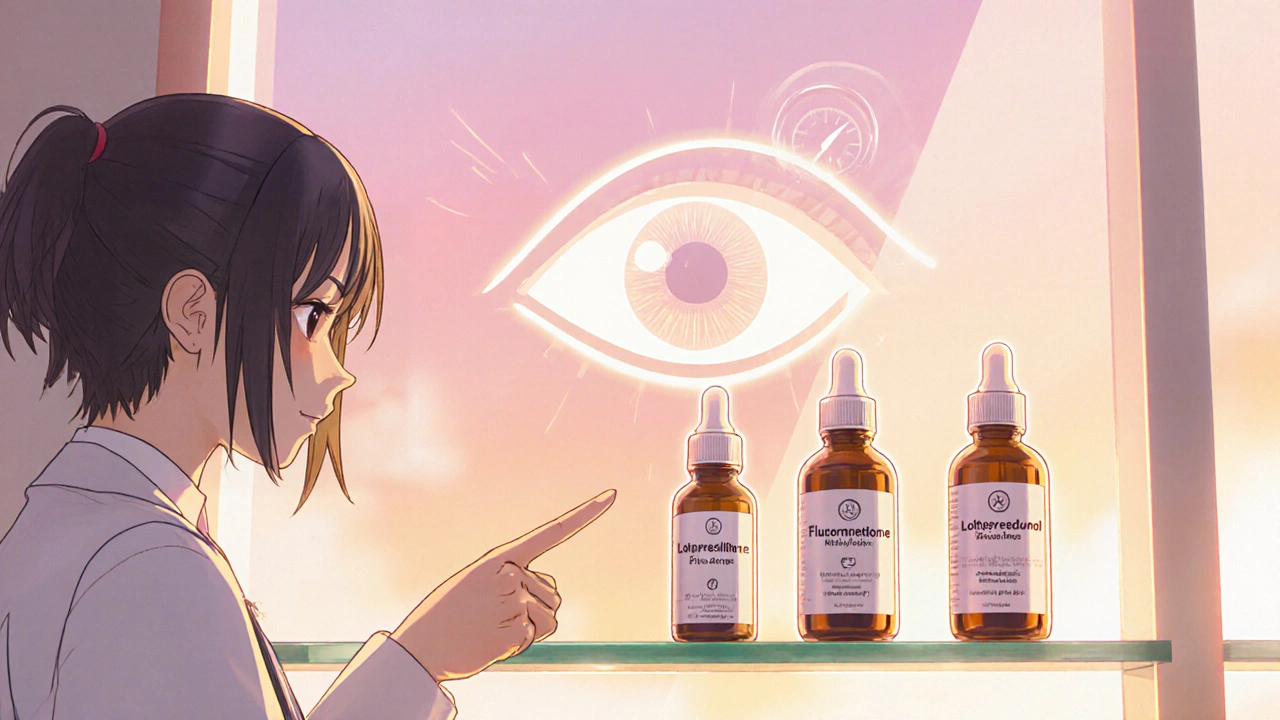
Fluorometholone Dosage Calculator
Calculate your personalized fluorometholone dosing schedule based on your condition and symptom severity. Always consult your eye specialist before starting treatment.
Your Personalized Treatment Plan
Initial Phase
Tapering Phase
Important Safety Notes
This calculator is for educational purposes only. Always consult your ophthalmologist for personalized medical advice. Prolonged steroid use increases risk of intraocular pressure elevation and cataracts.
When your eyes get red, itchy, or painful, a doctor might reach for a steroid eye drop. One of the most prescribed options is fluorometholone. This guide breaks down everything you need to know - from how the drug works to how to use it safely and what other treatments exist.
What is Fluorometholone?
Fluorometholone is a synthetic corticosteroid formulated for topical ophthalmic use. It was first approved by the U.S. Food and Drug Administration (FDA) in the early 1970s and has become a staple for treating inflammatory eye conditions.
How Does It Work?
Fluorometholone binds to glucocorticoid receptors in ocular tissues, suppressing the release of inflammatory mediators like prostaglandins and cytokines. By dampening this response, it reduces redness, swelling, and pain.
Approved and Common Uses
- Anterior uveitis - inflammation of the front part of the eye.
- Posterior uveitis - deeper inflammation that can affect vision.
- Allergic conjunctivitis - eye allergy flare‑ups.
- Post‑surgical inflammation - after cataract or refractive surgery.
Off‑label, some clinicians use it for keratitis or as a bridge when tapering stronger steroids.
Dosage Forms and Typical Regimens
Fluorometholone is usually supplied as 0.1% or 0.25% eye drops in preservative‑free containers. A typical adult regimen looks like:
- Start with one drop in the affected eye(s) every 2-4 hours for the first 2-3 days.
- Gradually taper to 1-2 drops daily over 1-2 weeks, depending on response.
- Never skip a dose if you’re experiencing acute inflammation; steady levels are key.
Children under 2 years old should only use fluorometholone under strict pediatric ophthalmology supervision.
How to Use the Drops Correctly
- Wash hands thoroughly before handling the bottle.
- Shake the bottle gently if the formulation is emulsion‑based.
- Pull down the lower eyelid to create a small pocket.
- Instill one drop without touching the tip to the eye.
- Close the eye gently for about 30 seconds to allow absorption.
- If you need to use other eye medications, wait at least 5 minutes between drops.

Potential Side Effects
Like all steroid eye drops, fluorometholone can cause local and systemic effects. Most patients experience mild irritation or a transient burning sensation.
| Category | Example | Incidence |
|---|---|---|
| Common | Transient stinging, blurred vision | 10-20% |
| Less common | Increased intraocular pressure (IOP) | 5-8% |
| Rare | Cataract formation, secondary infection | <1% |
Elevated IOP is the most concerning side effect because prolonged pressure spikes can lead to glaucoma. Patients on long‑term therapy should have IOP checked every 2-4 weeks.
Monitoring & Safety Tips
- Schedule follow‑up visits within 1 week of starting therapy.
- Report any worsening pain, vision changes, or new floaters immediately.
- Avoid wearing contact lenses while using the drops, unless prescribed as a bandage lens.
- Store the bottle at room temperature, away from direct sunlight. Discard after 30 days of opening.
Contra‑indications and Drug Interactions
Do not use fluorometholone if you have a known hypersensitivity to the drug or any component of the formulation. It should also be avoided in active ocular infections unless combined with antimicrobial therapy.
Potential interactions include:
- Other topical steroids - may increase cumulative side‑effect risk.
- Beta‑blocker eye drops - can mask early IOP rise.
- Systemic corticosteroids - additive systemic absorption, though rare.
Special Populations
- Pregnant women - limited data; use only if benefits outweigh risks.
- Breast‑feeding mothers - minimal systemic absorption, but monitor infant for any signs of irritation.
- Elderly patients - higher baseline IOP; more frequent pressure checks are advised.

How Fluorometholone Compares to Other Steroid Eye Drops
| Drug | Potency (relative) | Typical Duration | IOP Risk | Formulation Notes |
|---|---|---|---|---|
| Fluorometholone | Medium | 1-2 weeks | Moderate | Preservative‑free options |
| Prednisolone acetate | High | 1-2 weeks | High | Often contains benzalkonium chloride |
| Dexamethasone | High | Short‑acting | High | Very potent, used for severe inflammation |
| Loteprednol etabonate | Low‑to‑medium | 2-3 weeks | Low | Soft‑steroid, minimizes cataract risk |
If you’re worried about IOP spikes, loteprednol may be a safer alternative, but fluorometholone still offers a good balance of efficacy and tolerability for many patients.
Common Questions Patients Ask
- Can I stop the drops once my eye feels better? Stopping abruptly can cause a rebound flare. Taper gradually as instructed.
- Will the drops make my vision blurry? Some temporary blurring is normal. It usually clears within minutes.
- Do I need to wash my hands after each dose? Yes, to avoid contaminating the bottle and spreading infection.
Quick Reference Checklist
- Confirm diagnosis (uveitis, allergic conjunctivitis, post‑surgical inflammation).
- Prescribe correct concentration (0.1 % or 0.25 %).
- Explain proper drop technique.
- Schedule IOP monitoring after 2 weeks.
- Provide taper schedule in writing.
- Advise on storage - 30 days after opening.
Frequently Asked Questions
What conditions can Fluorometholone treat?
It is approved for anterior and posterior uveitis, allergic conjunctivitis, and post‑operative inflammation. Doctors also use it off‑label for certain keratitis cases.
How long does a typical treatment last?
Most regimens run 1-2 weeks, with a taper over the following week. Severe cases may require up to 4 weeks under close supervision.
Is Fluorometholone safe for long‑term use?
Long‑term use is possible but increases the risk of cataract formation and IOP elevation. Regular eye‑pressure checks are mandatory.
Can I use Fluorometholone with contact lenses?
It’s best to remove lenses before instilling drops and wait at least 15 minutes before reinserting, unless a bandage lens has been prescribed.
What should I do if I miss a dose?
Apply the missed dose as soon as you remember, unless it’s almost time for the next one. Never double‑dose.





Comments (7)
Giusto Madison
If you're dealing with inflamed eyes, the key is consistent dosing; never skip a drop because the therapeutic window closes quickly. Follow the prescribed schedule to the letter, especially the taper phase, or you risk a rebound flare that could set you back days. Each drop delivers a precise amount of corticosteroid, so missing one disrupts the drug's steady-state concentration. Use preservative‑free containers to avoid additional irritation, and keep the bottle capped tightly. Wash your hands before every application to keep the solution sterile. Remember that even a small lapse can trigger increased intraocular pressure, which is why regular IOP checks are mandatory during treatment. Treat the regimen like a daily habit, not an optional task. If you feel any burning, it's usually transient, but don't let it deter you from completing the course. Your vision health depends on adherence, not on occasional shortcuts. In short, stick to the plan and you’ll see the inflammation clear without complications.
Xavier Lusky
What most people don’t realize is that the pharmaceutical industry often downplays the long‑term risks of steroid eye drops. They push fluorometholone as a safe, mild option while quietly ignoring the data on subtle cataract formation and pressure spikes that can lead to glaucoma years later. The marketing brochures are full of glossy images, but the fine print reveals a pattern of minimal post‑market surveillance. Every time a new batch hits the shelves, a handful of patients report unexplained vision changes, yet those incidents are buried in undisclosed trial results. It’s a classic case of profit over patient safety, and the medical community seems far too complacent about it.
Esther Olabisi
Oh fantastic, another steroid drop to add to the daily drama 🎭👁️. Because who doesn’t love a little eye fireworks after a cataract surgery? The side‑effect list reads like a horror story, but hey, at least the redness goes away for a few minutes. 💥😊
Vivian Annastasia
Sure, let’s just trust that a few weeks of fluorometholone won’t mess with your eye pressure. It’s not like we’ve seen any cases where patients develop glaucoma after steroids, right? And those tiny risks on the label are probably just there for decoration. Who needs monitoring when you can just hope for the best.
John Price
Consistency beats occasional dosing.
Ericka Suarez
I cant even bElieve theyre still pushing thsi stuff onto us! The drama around "safe" steroid drops is just a marketing stunt. Who needs real data when you have glossy ads? It’s a total nightmare for anyone who actually cares about their vision.
Angela Koulouris
Think of the drops as a gentle tide washing away the inflammation, slowly but surely restoring clarity to your world. Each tiny parcel of medicine slips into the ocular surface, calming the angry cells without causing a storm.